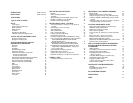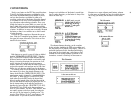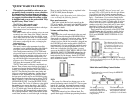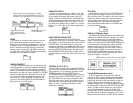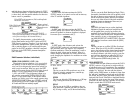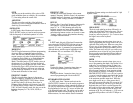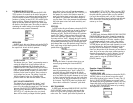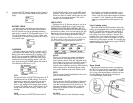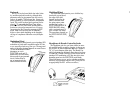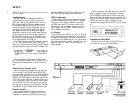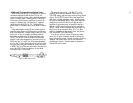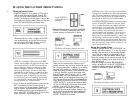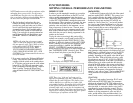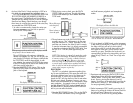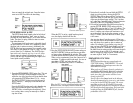
voices into the DX7 internal memory and then format if
you like.) You cannot format a ROM (factory preset) car-
tridge.
BATTERY CHECK
In function mode, this button causes the display to
show the voltage level of the battery which preserves
the DX7 internal voice and programming memories
when power is turned off. The acceptable range is 2.3 to
3.5 volts. If the battery is below 2.2 volts, contact your
Yamaha dealer to arrange for replacement; this is NOT a
do-it-yourself repair.
CARTRIDGE
This pair
of
buttons
sets
the
DX7
to transfer
a
full
32
voices between the internal and the cartridge memory
Before voices can be transferred TO a cartridge or TO
the DX7, the corresponding (MEMORY PROTECT)
features must be turned off. (Individual voices can be
transferred by first using the Play mode to "pick" the
voice, then pressing the [STORE] button and whatever
Voice Selector you like from 1 to 32.)
SAVE
Pressing this button in FUNCTION mode stores all 32
internal memories to a RAM cartridge. You have an
opportunity to cancel the command by answering
[NO] to either displayed prompt; otherwise any
voices in the cartridge will be erased when the tran-
ter occurs. The display shows "Under Writing" for 20
seconds while the voices are being "written" to the
cartridge.
LOAD
Pressing this button in FUNCTION mode loads 32
RAM or ROM cartridge voices into the DX7 internal
memories. Again, you have to answer [YES] twice
before the voices are loaded (which erases any exist-
ing voices in the internal memories). The actual
transfer occurs instantaneously
MODULATION
The bottom row of 16 Function buttons is used to set
the Modulation available from 4 control sources: the
MODULATION WHEEL, FOOT CONTROL, BREATH
CONTROL and key AFTER TOUCH. Since the 4 groups
are identical in nature, we'll cover the buttons just once.
Pressing any of these buttons activates the [DATA EN-
TRY] section so you can program different settings.
NOTE: if the Amplitude or EG Bias is turned On, with a
low Range setting, certain voices may be inaudible or
nearly so due to their high modulation sensitivity.
RANGE
This lets you program the amount of modulation
from none (0) to a maximum value (99). Bear in
mind, however, that the Pitch and Amplitude modu-
lation "range" may be zero (off) even if this control is
set at 99 unless the particular voice being played
includes some modulation sensitivity. Since sensitivity
differs between voices, the identical Range setting
may produce different results with different voices.
PITCH
This lets you turn On LFO modulation of the voice's
pitch for vibrato-like effects.
AMPLITUDE
This lets you turn On LFO modulation of the ampli-
tude (level) of those individual operators within a
voice that are programmed to be sensitive to it. The
effect may therefore be tremolo-like, or wah-like
depending on whether a carrier or modulator is
being modulated.
EG BIAS
This lets you directly control the operator output
level with the corresponding modulation control
(Foot, Breath, etc.). In this case, the LFO is not in-
volved. Again, this will produce changes in brilliance
or volume or "wah" depending on the amplitude
sensitivity programmed into each operator in the
voice.
Voice Cartridge socket
This socket accepts the ROM cartridges which each
hold 64 pre-programmed voices (two are supplied with
the DX7), or the RAM cartridges which each hold 32
user-programmed voices. A protective door automati-
cally swings away when a cartridge is inserted. The
cartridges have a slot in their end connector, and the
socket has a keyway so that the cartridges can only be
inserted fully when properly oriented. If a cartridge does
not seat properly turn it around and try again. DO NOT
FORCE a cartridge into place.
Power Switch
This rear panel switch turns power on, permitting
the DX7 to be played and/or programmed. The inter-
nal voices are preserved even when power is turned
off, so long as the internal battery can deliver at least
2.3 volts (which can be verified by selecting the
FUNCTION/Battery Check mode).
10



